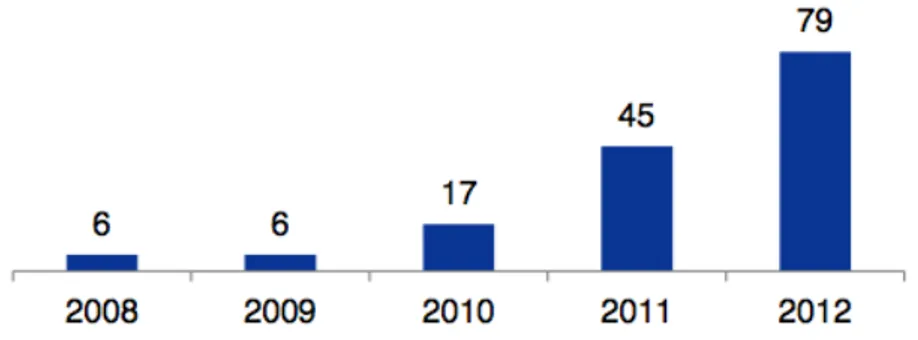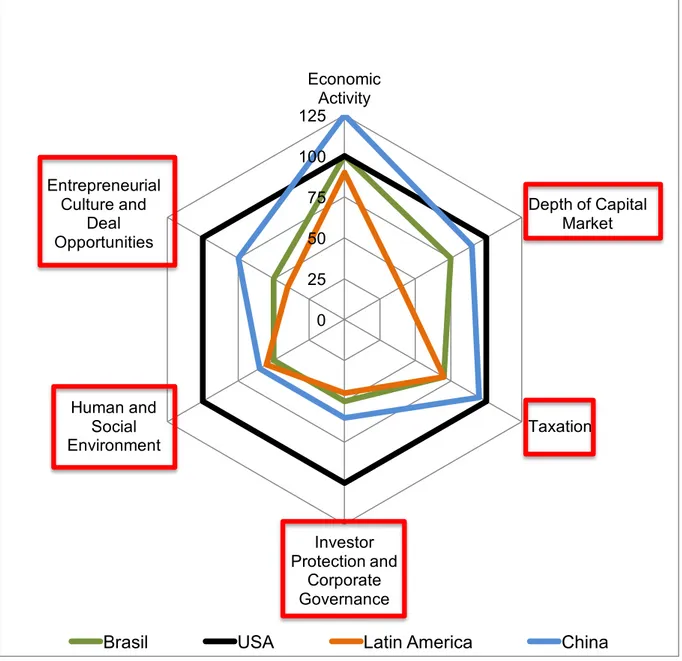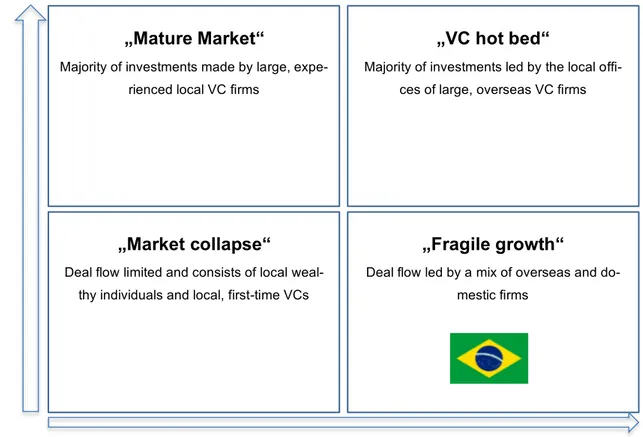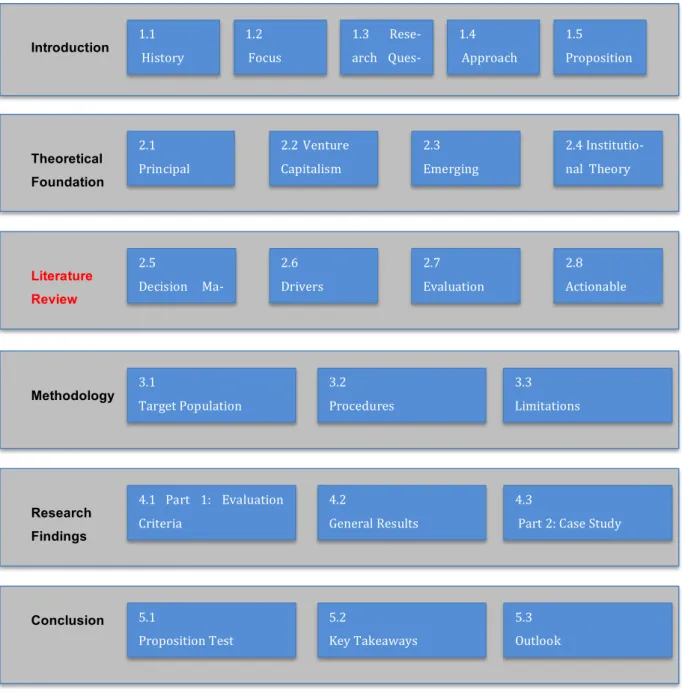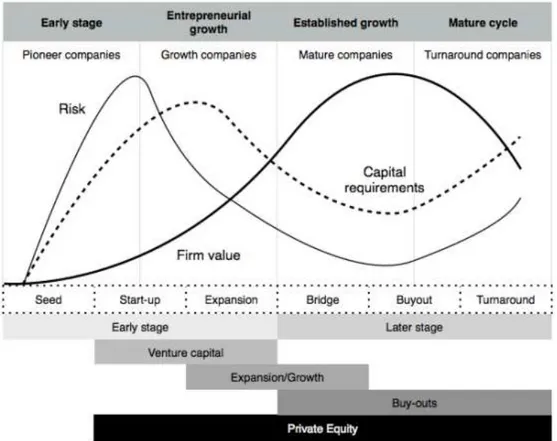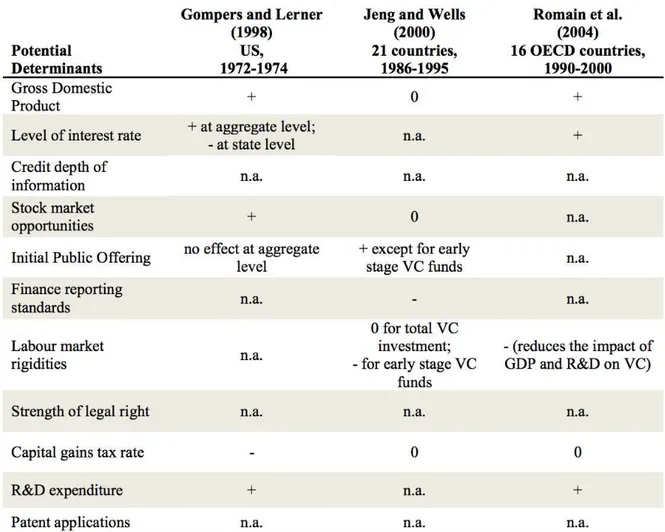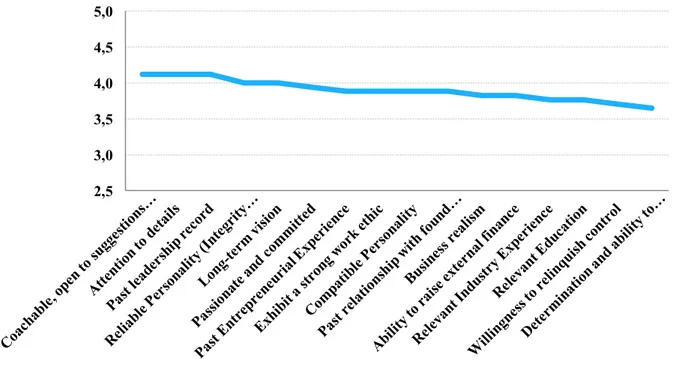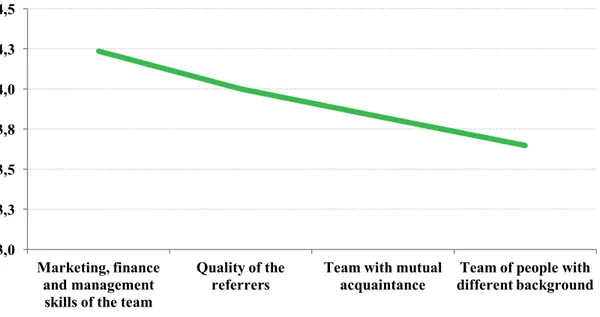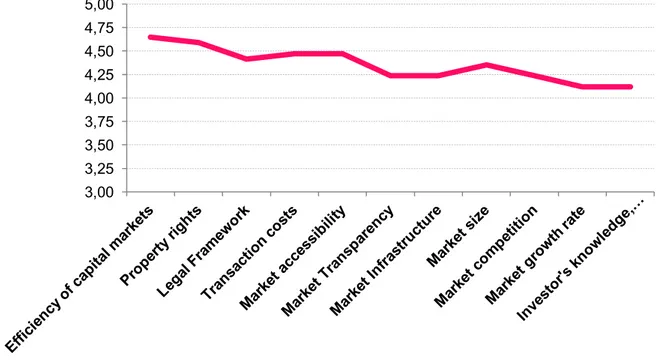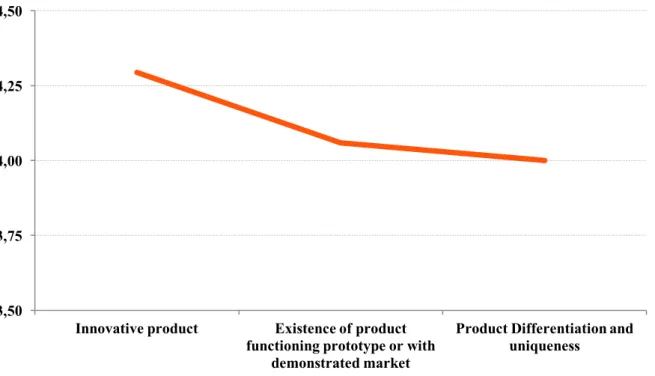FUNDAÇÃO GETULIO VARGAS
ESCOLA DE ADMINISTRAÇÃO DE EMPRESAS DE SÃO PAULO
CHRISTIAN ALEXANDER ALBRECHT
WINNING IN BRAZIL: HOW INSTITUTIONAL VOIDS AFFECT THE ENTRY DECISIONMAKING PROCESS OF FOREIGN VENTURE CAPITAL FIRMS
COMING TO BRAZIL
FUNDAÇÃO GETULIO VARGAS
ESCOLA DE ADMINISTRAÇÃO DE EMPRESAS DE SÃO PAULO
CHRISTIAN ALEXANDER ALBRECHT
WINNING IN BRAZIL: HOW INSTITUTIONAL VOIDS AFFECT THE ENTRY DECISIONMAKING PROCESS OF FOREIGN VENTURE CAPITAL FIRMS
COMING TO BRAZIL
Thesis presented to Escola de Admin istração de Empresas de São Paulo of Fundação Getulio Vargas, as a re quirement to obtain the title of Master in International Management (MPGI).
Knowledge Field: Venture Capital
Adviser: Prof. Dr. Tales Andreassi
Albrecht, Christian.
Winning in Brazil: How institutional voids affect the entry decision making process of foreign venture capital firms coming to Brazil/ Christian Albrecht. 2015.
85 f.
Orientador: Tales Andreassi
Dissertação (MPGI) Escola de Administração de Empresas de São Pau lo.
1. Processo decisório. 2. Investimentos estrangeiros Brasil. 3. Capital de risco. 4. Empresas multinacionais. I. Andreassi, Tales. II. Dissertação (MPGI) Escola de Administração de Empresas de São Paulo. III. Título.
CHRISTIAN ALEXANDER ALBRECHT
WINNING IN BRAZIL: HOW INSTITUTIONAL VOIDS AFFECT THE ENTRY DECISION MAKING PROCESS OF FOREIGN VENTURE CAPITAL FIRMS
COMING TO BRAZIL
Thesis presented to Escola de Admin istração de Empresas de São Paulo of Fundação Getulio Vargas, as a re quirement to obtain the title of Master in International Management (MPGI).
Knowledge Field: Gestão e Competi-tividade em Empresas Globais
Approval Date ____/____/_____
Committee members:
_______________________________ Prof. Dr. Tales Andreassi
_______________________________ Prof. Dr. Gilberto Safarti
_______________________________ Prof. Dr. Marcos Hashimoto
ABSTRACT
The Master Thesis for the achievement of the academic status Master of Science in International Management (MPGI) will aim to solve the research question of how institutional voids affect the entry decisionmaking process of foreign venture capital firms coming to Brazil. This is a timely matter since in the past years there has been a sudden eruption of foreign VC involvement in Brazil. Based on the Actionable Framework by Khanna and Palpeu (2010) we conducted quantitative as well as qualitative research with two sets of interview partners in a twophase analysis. We interviewed experts from VC firms, foreign VC firms based in Brazil and perspective VC firms that are looking to come to Brazil. We started with the former, derived les sons learned and analyzed how they affect the latter in reaching a decision. As we expected we found that depending on the industry that ventures are in, institutional voids can either pose an opportunity or a threat and hence attract or push away potential VC firms entering Brazil. Opportunities exist especially when exploiting institutional voids, for example through ventures in the marketplace efficiency. Threats are posed by investments in for instance hard infrastructure, where the economic, political and judicial systems as well as corruption and bureaucracy play demanding roles.
KEY WORDS: venture capital, institutional voids, Brazil
RESUMO
A tese de mestrado para a realização do acadêmico estado Master of Science in International Management (MPGI) terá como objectivo resolver a questão de como vazios institucionais afetar a decisão entrada de empresas de capital de risco es trangeiro que vêm ao Brasil a pesquisa. Esta é uma matéria oportuna uma vez que nos últimos anos tem havido uma súbita erupção de envolvimento VC estrangeiros no Brasil. Com base no quadro acionável por Khanna e Palpeu (2010) realizamos quantitativa bem como qualitativa repesquisa com dois conjuntos de parceiros de entrevista em uma análise em duas fases. Entrevistamos especialistas de empre sas de VC, VC empresas estrangeiras sediadas no Brasil e as empresas de capital de risco perspectiva que estão olhando para vir ao Brasil. Começamos com as an tigas lições aprendidas, derivados e analisados como eles afetam o último em che gar a uma decisão. À medida que experado descobrimos que dependendo da in dústria que estão em ventures, vazios institucionais pode representar uma oportun idade ou uma ameaça e, portanto, atrair ou afastar potenciais empresas de capital de risco que entram Brasil. As oportunidades existem, especialmente quando ex plorando vazios institucionais, por exemplo através de empreendimentos na eficiência de mercado. Ameaças provenientes de investimentos em infraestrutura para o disco exemplo, onde os sistemas econômicos, políticos e judiciais, bem co mo a corrupção ea burocracia desempenham papéis exigentes.
PALAVRAS CHAVE: venture capital, institutional voids, Brasil
Abbreviation Index
ABVCAP Brazilian Venture Capital and Private Equity Association BRIC Brazil, Russia, India, China
CVM Comissão de Valores Mobiliários GDP Gross Domestic Product
MIT Massachusetts Institute of Technology MNC Multinational Corporation
PE Private Equity
SPV Special Purpose Vehicle
VC Venture Capital
WEF World Economic Forum
Table of Figures
Figure 1: Number of VC Investments in Brazil………...1
Figure 2: PEVC attractiveness index 2013 ... 12
Figure 3: VC market landscape matrix ... 13
Figure 4: Setup of research paper ... 16
Figure 5: PE Segmentation and financing stages………10
Figure 6: Decision-making criteria……….23
Figure 7: List of interview partners………26
Figure 8: Case Study Participants ... 44
Figure 9: Five point unipolar scale……….……….29
Figure 10: Overall Results ... 46
Figure 11: Entrepreneur Results ... 48
Figure 12: Management Team Results ... 50
Figure 13: Market Results ... 51
Figure 14: Product Results ... 54
Figure 15: Financial Aspects ... 55
Table of Content
Abbreviation Index ... 7
Table of Figures ... 7
1 Introduction ... 10
1.1 Brief History and Current Situation of the VC Landscape in Brazil ... 10
1.2 Research Focus and Objective ... 13
1.3 Research Question ... 14
1.4 Research Aim and Approach ... 14
1.5 Propositions ... 16
2 Literature Review ... 18
2.1 Principal Agent Theory ... 18
2.2 Venture Capitalism ... 18
2.2.1 Distinction to Private Equity ... 18
2.2.2 Determinants of VC Intensity ... 21
2.3 Emerging Markets ... 23
2.3.1 Classical Approach ... 23
2.3.2 Structural Approach – Institutional Voids ... 24
2.4 Institutional theory ... 26
2.5 VC Decisionmaking Process ... 26
2.6 Drivers of the investment decisionmaking process ... 29
2.6.1 Deal Generation ... 30
2.6.2 Screening ... 30
2.6.3 Role of Behavioral finance in Decision Making Processes ... 32
2.7 Evaluation Criteria ... 33
2.8 An Actionable Framework ... 36
3 Methodology ... 37
3.1 Methodological Procedures ... 37
3.2 Data analysis process ... 42
3.4 Limitations ... 44
4 Research Findings ... 45
4.1 Part 1: Evaluation Criteria ... 45
4.2 General Results ... 46
4.2.1 Entrepreneur ... 47
4.2.2 Management Team ... 49
4.2.3 Market ... 50
4.2.4 Product ... 53
4.2.5 Financial Aspects ... 54
4.2.6 Other Criteria ... 55
4.2.7 Key Takeaways ... 56
4.3 Part 2: Case Study Analysis ... 58
4.3.1 Nordwind Capital GmbH ... 58
4.3.2 Early Bird – Venture Capital ... 62
5 Conclusion ... 65
5.1 Key Findings ... 65
5.2 Proposition Test ... 69
5.3 Further Research ... 70
6 References ... 71
7 Appendix ... 77
7.1 Raw Research Results ... 77
7.2 Nordwind Capital Interview Results ... 81
1 Introduction
1.1 Brief History and Current Situation of the VC Landscape in Brazil
Generally speaking the history of VC activity in Brazil can be distinguished in three time periods, 1980to1995, 1995to2005 and 2005topresent (Ernst & Young, 2012). In early 1980’s Brazil saw the first VC firms arise that struggled with pioneer ing challenges amidst an economic environment unfriendly to longterm investments due to high inflation and interest rates. This also had a huge impact on nominal re turn rates as they varied greatly with the inconsistent inflation. With the introduction of the Real Plan in 1995 this environment changed in favor to VC firms as inflation was lowered and interest rates were soon to follow. The ongoing privatization of pub lic companies increased the prospect of small companies as competitors and as suppliers. Furthermore the industry matured with the emergence of the first regulato ry institution with the CVM and the first incubators. With the start of the new millenni um the industry reached its next milestone with the creation of the Brazilian Venture Capital and Private Equity Association (ABVCAP) that brought together several of the industries key players. (GVcepe, 2012) Overall the turn of the millennium chartered the advent of a new entrepreneurial enthusiasm in Brazil opened up many new in vestment opportunities for VC funds and strengthened their stance as financial vehi cles. Fueled by the booming middle class and stock market in Brazil in 2005, pension funds and institutional investors started looking towards VC funds for alternative in vestment opportunities which brought about a new generation of VC and PE funds (Ernst & Young, 2012).
Nowadays the major growth drivers within the VC industry are the lower interest rates, an appreciation of the currency, the increasing C and D classes (middle class), the government housing projects, the real estate boom and many more. “Where there is growth, there is opportunity for the VC industry” (Ernst & Young, 2012) and this especially exists as part of the infrastructure and logistics projects that the World Cup in 2014 and the Olympics in 2016 entail.
class, critical mass of highly engaged digital users, and significant room for broad band and smartphone penetration growth, the precursor believes the Brazil is ripe to grow a crop of internet giants.” (Wallace & Holda, 2013)
Following the Silicon Valley example the current wave of investment is fo cused on replicating proven business models and applying them to the Brazilian con text – particularly ecommerce and digital media. It is anticipated that this focus will shift in the years to come to innovative and unique business models that serve to better the market place in Brazil and eventually the world. As the confidence in the Brazilian market environment evolves, investors will be more comfortable taking business model risks (Wallace & Holda, 2013).
As we can deduce from the table above, there has been a rapid expansion of the VC activity in Brazil, especially since 2012. The reason for this being the appear ance of foreign funds that have invested infrequently in opportunistic investments and an emergence of accelerators and socalled super angels. (GVcepe, 2012)
Whilst the numbers seem optimistic, the reality is far from it. Following a re search conducted by the MIT Sloan School of Management Brazil’s VC sector is ac tually decreasing when measuring the amount of capital influx by 40% (Wallace & Holda, 2013). Furthermore, according to their research that is based on the Global Attractiveness Index when comparing the ecosystems of the BRIC and developed countries, Brazil is trailing the entire field. According to Wallace & Honda (2013), Brazil has to overcome the following challenges if they want to compete for foreign investment with the other BRIC countries:
“Complex, multilayered tax regime burdens SMEs and investors with major com pliance costs and high tax rates.
Convoluted business regulatory system makes it extremely time consuming and Figure 1: Number of VC Investments in Brazil Source: Startup
expensive to start businesses.
Restrictive labor laws make it challenging to scale businesses up and down quickly, and create longterm liabilities.
Lagging educational system and cultural aversion to entrepreneurship driving shortage of human capital in early stage technologies.”
These factors become evident in when you compare Brazil to its peers on the basis of the global PEVC attractiveness index published every year by IESE University in Barcelona (2013).
Figure 2: PEVC attractiveness index 2013 Source: IESE, 2013
In all areas, except the economic activity, Brazil trails its peers. Although the high 0
25 50 75 100 125
Economic Activity
Depth of Capital Market
Taxation
Investor Protection and
Corporate Governance Human and
Social Environment Entrepreneurial
Culture and Deal Opportunities
growth, large market and rising middle class indicate the potential of the Brazilian economy, its legal, economic and social framework lags behind to support it. Hence it is conclusive to predict that institutional voids are a key influencer of PEVC activity in a respective country.
Hence when mapping out the four different scenarios of possible state of the unions for the VC industry, Wallace et. al. (2013) position Brazil in the fragile growth seg ment which constitutes a deal flow led by a mix of overseas and domestic firms. Ac cording to Wallace et. al. (2013) this is backed up by the recent wave of US firms that have come to Brazil and sought limited partnerships with domestic Brazilian VC funds to recreate a “Silicon Valley” like atmosphere with ventures of equal structure and agility.
Figure 3: VC market landscape matrix Source: (Wallace & Holda, 2013)
1.2 Research Focus and Objective
Over the past decade, Brazil has developed into a highly attractive economy. In light of this positive economic climate, supported by strong fundamental economic data, one would expect Brazil to be a highly attractive market for foreign venture
capital firms. However, only very little research has been conducted in this highly in teresting field in such a dynamic region. In view of this lack of literature, this paper will attempt to fill the gap by conducting an exploratory study into the Brazilian ven ture capital market and the foreign players that have already arrived.
Based on the theory of institutional voids set forth by Tarun Khanna and Krishna G. Palepu of the Harvard Business School in the book Winning Emerging Markets: A Road Map for Strategy and Execution, this study will examine how institutional voids affect the entry decision of foreign venture capital firms that want to enter the Brazili an market.
1.3 Research Question
As identified in the introduction, more and more foreign VC firms have arrived in Brazil and are looking for alternative investment opportunities in the very promising market environment of Brazil. Although, along with its BRIC peers, Brazil has in the past decade seen continuous growth and is acclaimed to surpass many of the G6 countries in GDP output by 2050, it has not yet been able to shake off the status as an emerging economy. Khanna and Palepu (2010), explain this by highlighting that the existence of institutional voids hinders the country from closing in on the devel oped economies. In other words, marketplace inefficiencies, a lack of specialized intermediaries and high transactional costs are key characteristics of emerging econ omies. This research paper will aim to investigate how the stigma of an emerging economy and the institutional voids that exist within Brazil either hinder or attract for eign VC firms that want to enter Brazil. The research question that follows is:
How do institutional voids affect the entry decisionmaking process of foreign venture capital firms in Brazil?
1.4 Research Aim and Approach
identify the lessons learned, which will hopefully help us to derive a set of criteria that will form the basis for the second step of our analysis: expert interviews with leading VC firms from Europe and the United States, who have yet to invest in Brazil. This twostep analysis will help facilitate a better understanding of the VC ecosystem in Brazil by identifying which institutional voids exist and how they hinder and alter the entry strategy for foreign VC funds. Since the study is aimed at answering the ques tion of how institutional voids affect the entry decisionmaking process of foreign VC firms coming to Brazil, we will focus our research on the last strategic sphere outlined by Khanna and Palepu (2010) in their Actionable Framework: Enter, wait, or exit? The following diagram illustrates the setup of the research paper.
Figure 4: Setup of research paper Source: Own Diagram
1.5 Propositions
As indicated in the introduction of this research proposal, the Brazilian VC eco system is set up for transformation. With a soaring amount of active participants, the investment portfolio of VC firms is becoming more diversified and tested. With returns set to materialize, foreign investors will be increasingly attracted to enter the Brazilian market. As confidence increases and market conditions start to become more favor able, so will the investor sentiment. Taking all the market conditions into respect, I believe that following an implication by Introduction 1.1 History 1.2 Focus 1.3 Rese‑ arch Ques‑ 1.4 Approach 1.5 Proposition Theoretical Foundation 2.1 Principal 2.2Venture Capitalism 2.3 Emerging 2.4 Institutio‑ nal Theory Literature Review 2.5 Decision Ma‑ 2.6 Drivers 2.7 Evaluation 2.8 Actionable Methodology 3.1 Target Population 3.2 Procedures 3.3 Limitations Research Findings
Khanna and Palepu (2010) that highlights the (a) synergies that exist through strate gic alliances with native partners in emerging economies; connecting with local know how in the industry will reduce the hesitancy of foreign VC firms to enter. This effect will be amplified as local Brazilian VC firms start to grow and extend their investment portfolio. With respect to answering the research question of how institutional voids affect the entry decision of foreign VC firms into the Brazilian market, I expect to find that (b) especially for VC firms, who amongst others, historically invest in internet driven ventures focused on ecommerce, travel and marketplaces, the existence of institutional voids poses a great opportunity to develop the countries soft infrastruc ture. In other words, institutional voids can be a driver, because ultimately, with re spect to the rising middle class and online population, the opportunity exists. And opportunity means growth, and growth drives returns. On the other hand, (c) when talking about ventures in different industries, for example the hard infrastructure in dustry, institutional voids will dampen the moods for VC firms to engage in projects since the complexity of the economic, political and judicial environment is beyond the scope of foreign investors that have little or no affiliation with the common practices in Brazil.
2 Literature Review
2.1 Principal Agent Theory
The demand and supply of capital mainly depends on the credibility of the prom ise and the ability of the entrepreneur to pay back the invested money received by the financiers. Such credibility is however threatened by information asymmetry and conflicts of interest between the objectives and orientations (Pissarides, 1999) of the investor and those of the entrepreneur. The entrepreneur usually has financial and nonfinancial goals whereas the investor is typically interested in the project’s finan cial success (Garnsey, 1998) In 1932, Adolph Berle and Gardiner Means analyzed the consequences of the separation of control and property. Their study leads to the creation of the renowned “AgencyTheory Model” which states that the interests of the principal and agent might differ (Garnsey, 2002)
In investment decisions, information asymmetry becomes a threat exante and expost. The former through adverse selection which states that due to imperfect in formation the investor might not choose the optimal allocation of resources since the managers might overstate the potential of their particular investment. The latter being moral hazard, which constitutes the phenomenon that once the funds have been al located, managers are potentially incentivized to live off their managerial fees and neglect the value maximization of the investment incurred (Ross et al., 2012). In fear of this, investors tend to withhold their investments, which leads to a phenomenon of credit and equity rationing (Stiglitz & Weiss, 1981) where a significant number of po tential ventures are left without access to capital funds or might obtain funding at un reasonable cost. The consequences just described of information asymmetry are greater in developing countries than in developed countries due to a lack of sot and hard infrastructure (Berger & Udell, 1998). The problem is even more amplified when it comes to new ventures and growth firms: since they are still young in their maturity, their value is not recognizable as well as their potential for future growth.
2.2 Venture Capitalism
2.2.1 Distinction to Private Equity
sion of equity capital by financial investors, over the medium and long term to non quoted companies with high growth potential“ (Gompers & Lerner, 1998). The fine line between these two investment vehicles lies in the stage in which the investment is incurred. Venture capital firms invest in the “later technology research, develop ment and the early manufacturing and scalingup phase” (Jeng & Wells, 2000) Therefore, they finance new or radically changing ventures differing significantly from established companies, whereas the challenge of information asymmetry merits spe cial attention (Wright & Robbie, 1998, p. 552). Private Equity firms, on the other hand, do not only cover the early developing stages of a venture, but also the later stages of a venture’s life cycle (Gompers & Lerner, 1998) Consequently, venture capitalism can be seen as a subcategory of private equity.
Figure 2 shows the PE segmentation and the financing stages. The seed stage is only a prequel to private equity, despite a latent need for financing. The reason for this is the absence of management and ample business plans which forces entrepre neurs to focus on marketability, feasibility and other operational issues instead of raising funds. In general, capital requirements are usually limited in volume at such an early stage, which does not incentivize the founders to look for investors, since they would have to give up a sizable amount of equity against a limited amount of starting capital (Bader, 1996, p. 105). In literature this phenomenon is often de scribed as the equity gap, which is filled by the presence of angel investors, family or friends.
According to Bader’s analysis, the next two stages – startup and expansion – are the dominion of venture capitalists (p. 105). Arriving at these stages, potential startups have successfully overcome the challenges of the seed stage: there is a defined product pipeline as well as a functional organizational structure. Concentra tion shifts towards strengthening operations and reinforcing the management. Ven ture capital provides best practices and finances the predicted growth, while bearing
the risk of failure. As opposed to the startup phase, companies in the expansion phase have successfully penetrated the market but have not yet been able to turn a profit. They require additional capital influxes to expand their operations, such as fur thering output capabilities and sales outreach – while many startups experiencing fast growth must deal with increasing working capital needs (Bader, 1996, p. 105). These young firms are very attractive for venture capital investors because their high growth potential has already been demonstrated, signaling promising cash flow per spectives for equity holders. Investment risks are mainly internal according to Bader (1996, p. 107), since marketability has already been proved at this development stage. Venture capital investment is typically made in the form of pure equity, due to the present unavailability of cash flows (loan interest payment is thus not an alterna tive). Modern day venture capital is frequently related to high tech companies, alt hough most venturebacked firms rarely develop new technologies due to the inher ent financial risk. Companies thus commonly work on new features based on known technology to fill a gap in the market; investors take a commercial risk rather then a technological risk (Bader, 1996). A notable exception is biotechnology, where major scientific breakthroughs can be synonymous with commercial success (Fraser Sampson, 2006).
2.2.2 Determinants of VC Intensity
Figure 6: Determinants of VC intensity Source: Chang (2014)
search paper won't have the capacity to give a reasonable conclusion on the level of significance of specific criteria, but it does try to rank them according to their im portance in the context of the Brazilian VC ecosystem.
2.3 Emerging Markets
2.3.1 Classical Approach
The term emerging markets has been around for almost three decades. It ap peared for the first time in 1981, when it was used by the International Finance Cor poration (IFC) to characterize the first mutual fund investments in developing coun tries. Ever since then and in almost every economical and political magazine this term has been omnipresent when discussing the economies of Brazil, Russia, India and China. A landmark Goldman Sachs report from 2003 was the first to highlight these four countries when it forecasted that the economies of the BRICs (Brazil, Russia, India, China) would grow to be collectively larger than the G6 economies (United States, United Kingdom, Japan, Germany, France and Italy) (Goldman Sachs, 2003). In literature the following criteria are famously used to characterize the attrib utes of emerging economies: (Khanna & Palepu, 2010)
Poverty Low or middleincome country
Low average living standards
Not industrialized
Capital Markets Low market capitalization relative to GDP
Low stock market turnover and few listed stocks
Low sovereign debt ratings
Growth potential Economic liberalization
Open to foreign investment
has fundamentally changed their economic environments. The result being that these economies have outpaced the GDP growth rates of those of developed countries over the past decade, lifting people from poverty, creating a new middle class and markets for consumer products and services. Furthermore the large, lowcost, and increasingly educated labor pools give these markets tremendous competitive ad vantage in production and information technology is enabling companies to exploit labor in these markets in unique ways.
2.3.2 Structural Approach – Institutional Voids
Tarun Khanna and Krishna G. Palepu of the Harvard Business School have a different stance on the subject. In the book Winning Emerging Markets: A Road Map for Strategy and Execution they argue that although the foregone characteristics highlight important features of the countries that are denounced to be emerging, they are not the characteristics that “predispose an economy to be emerging, nor are they particularly helpful for businesses that seek to address the consequences of emerg ing market conditions.” (Khanna & Palepu, 2010, p. 23) Rather these characteristics are the symptoms that arise from underlying market structures that prevail in each of these economies. Following Khanna and Palepu emerging markets “reflect those transactional arenas where buyers and sellers are not easily or efficiently able to come together.” (Khanna & Palepu, 2010, p. 23)
The importance of institutional voids as indicators for GDP growth has been supported by The Global Competitiveness Report 20102011 issued by the World Economic Forum, GDP growth is determined by the combination of the following three pillars: (World Economic Forum, 2011) Basic requirements (i.e. institutions, in frastructure, macroeconomic environment etc.), Efficiency Enhancers (i.e. higher ed ucation and training, Labor market efficiency etc.) and Innovation Factors (i.e. busi ness sophistication).
systems are three main sources of market failure that exist in emerging economies and spook off foreign players. (Khanna & Palepu, 2010) The real indicator for the grade of development, as stated by Khanna and Palepu are transaction costs. They offer an insight into how efficiently a market works, it includes all the costs associated with conducting a purchase, sale, or other enterprise related transaction. Generally speaking, developed economies have low transaction costs, high liquidity, high de grees of transparency and short time periods to complete transactions. In compari son to the classical definition of emerging markets, the structural definition states that “emerging markets are those where the specialized intermediaries are absent or poorly functioning.” (Khanna & Palepu, 2010)
Hence we can deduct that institutional environments in emerging economies differ greatly from those of established economies, which can have various implications for entrepreneurship in said regions (Ahlstrom & Bruton, 2010; Bruton, Ahlstrom, & Li, 2010). Bjerregaard and Lauring (2012) illustrate in more depth how entrepreneurs handle institutional malfeasance, working around and brokering contradictory institu tional logics. Amongst the entrepreneurs they studied one is effective in “bridging institutional contradictions” (Bjerregaard & Lauring, 2012: 31), by distancing himself from local traditions and thus openly bringing in new values, while the other entre preneur draws heavily on traditional normative patterns to ensure legitimacy for his entrepreneurial activities.
economies to overcome the obstacles set forth by institutional voids (Obloj, Obloj, & Pratt, 2010).
2.4 Institutional theory
According to North (1990), “institutions are the rules of the game in a society or, more formally, are the humanly devised constraints that shape human interactions.” Conversely, institutional theory endeavors to explain the influence that contextual systems have on economic performance and organizational behavior (Hoskisson, 2000). Whilst developed economies tend to have transparent and advanced institu tions, the opposite tends to hold true for developing economies, especially with re gards to the financial and legal frameworks (Pissarides, 1999) These are typically characterized by relatively minor private savings, weak financial intermediaries, shal low financial markets, feeble property rights and immature legal systems (Pissarides, 1999) Thereby organizations that operate in said emerging markets face high bu reaucracy and information processing costs due to the insufficient supply of well functioning institutions (North, 1990). Hence the absence of institutions will have a negative effect on the entrepreneurial spirit and thus on the development of venture capitalism.
Over the course of the decade, institutional theory has become increasingly im portant in assessing the development of venture capitalism in emerging economies. Pissarides (1999) use Scott’s (1995) institutional context typology and propose that cognitive institutions, such as networks etc., will act as enablers for venture capitalist development in the absence of regulatory institutions.
2.5 VC Decisionmaking Process
the realization of the investment; (8) Entrepreneur's exit and evaluation by VC; (9) Postexit monitoring by VC; (10) Postexit career planning including retirement, con sultancy, venture by another financial investor and the managerial career of the en trepreneur. This methodology is exceptionally thorough and demonstrates all the ac tivities that are included in the VC cycle. Particularly the raising money stage before the real process and the last stage demonstrating that leaving an organization does not finish the exercises of a VC help to round off the procedure. For VCs it is critical to stay informed concerning the investments they put resources into, to be prepared for future ventures. The model proposed reflects in more detail the methodology by Gomper and Lerner. Getting from the diverse methodologies, and also from samples utilized as a part of practice this thesis characterizes the phases of the venture deci sion making process as: "deal generation", "screening", "evaluation", "due diligence", "deal structuring", "monitoring" and "exit". Despite the fact that this model disregards the preventure investing stage, and the postexit exercises, it concentrates on the most critical stages significant for this thesis (for review see Table 2).
Gomper & Lerner (2001) Wells (1974) Tyebjee & Bruno (1984) Hall & Hof er (1993) Robbie & Wright (1998) Terminology for the Thesis
Fundraising Fundraising
Venture In vesting Search Deal Origina tion Generating Deal Flow Deal Genera tion Deal Genera tion Screening Screening Proposal
dure. They figured out that the criteria with which ventures were rejected for invest ments changed throughout the venture process. While in the screening and further assessment stage, product related criteria ruled, later on financial valuation and deal structure criteria as well as firms not reacting were more applicable.
2.6.1 Deal Generation
Several studies distinguish three fundamental deal generation sources: referrals, direct approach by the entrepreneur, and dynamic inquiry by the VC. Three sorts of referrals are recognized. Referrals begin from the funding group. Regularly bringing about a typical practice called syndication, where the alluding financial speculator takes the part of the lead financial specialist searching for a coinvestor. The primary point of interest is that the coinvestor is empowered to expand his portfolio without having the managerial hassle (Tyebjee & Bruno, 1984). Referrals also come from previous portfolio organizations, individual connections or, through banks and in vestment dealers (Tyebjee & Bruno, 1984). The deal origination through referral is thought to be a standout amongst the most essential sources, albeit direct inquiry by investors themselves is turning out to be more successive Wells (1974. Emerging industries as well as the entrepreneurial nature of young ventures are described by high vulnerability and information asymmetries (Gompers & Lerner, 2001). Hampl, Wuebker and Wüstenhagen (2012) state that under such circumstances immediate, through individual connections between the investors and the referrer (Shane & Ca ble, 2002) and indirect, beginning from relative status of the referrer in its network system ties assume a urgent part. Regardless, individual ties (direct ties) are seen to be more vital in high instability settings.
2.6.2 Screening
1984). A few studies express that the beginning screening procedure of customary financial investors is guided by trust related general criteria, for example, the industry and geographic center, the favored financing stage (e.g. seed capital, which are re lated to their risk preferences and ultimately the fund policy (e.g. amount of invest ments) (Hall & Hofer, 1993; Tyebjee & Bruno, 1984).
field of the venture and the capacity of the group to experience great and terrible times) is by all accounts vital. To wrap things up, the normal monetary returns are stressed (e.g. Singed & Hisrich, 1994; Hall & Hofer, 1993;; Robbie & Wright, 1998).
2.6.3 Role of Behavioral finance in Decision Making Processes
intellectual predisposition as of late considered is the impact of experience on the precision of the choice. Experienced VCs are expected to apply an arrangement of heuristics built up through their expanded experience, unwilling to the consideration of new variables, which can prompt wrong choices (Shepherd, et al., 2003; Tversky & Kahneman, 1974). These are only a couple of cases speaking to the predispositions that are found in VCs' venture conduct. Keeping in mind the end goal to conquer the se predispositions and to build the decision consistency distinctive models are rec ommended. Actuarial decision models separate the entire VC proposition into single segments, for example, the management, the product and the business sector and afterward reassemble them again to achieve a decision (Zacharakis & Meyer, 2000). Zacharakis and Shepherd (2001) further propose the presentation of counterfactual thinking where the VC should challenge the decision made by imaging distinctive situations or the utilization of a scorecard of criteria considered in past choices as a rule. Regardless, countering those researchers accepting that people under vulnera bility and time confinements are not judicious and consequently may take secondary choices because of the use of heuristics in their choices, there is another field of ex amination that contends in an unexpected way. The intuitive use of heuristics and subsequently the decrease of accessible information in complex decisionmaking process can bring about better choices. Before an official decision in light of heuris tics the quality is not clear. Whether heuristics impact the decision making process positively relies upon the structure of the decision making environment (e.g. Gigeren zer & Gaissmaier, 2011)
2.7 Evaluation Criteria
Stark, 2004). In addition the management and the entrepreneur must show a real understanding of how to run and to value the business as well as a strong work ethic, honesty, integrity and openness. VCs like investing in entrepreneurs who have sev eral successful startups on their resume. VCs expect a more handson role in the project than private equity, since they are then more concerned about the “chemistry” between the entrepreneur and themselves at this very early stage (Van Osnabrugge & Robinson, 2000; Haines et al, 2003; Mason & Stark, 2004). However, this is con tradictory to the earlier findings of Riding et al. (1995) that “investor fit” is less of a consideration at this stage. Entrepreneurs who are unlikely to be successful in getting financing are those who (i) ignore the advice from a business angel on a revised business plan; (ii) see venture capitalists as a last resort of getting finance; and (iii) simultaneously approaching several venture capitalists at the same time (Mason & Harrison, 1996a). A critical aspect is the entrepreneur’s willingness to surround him/herself with the most qualified and capable management team. Indeed, accord ing to Haines et. Al (2003), people in the project are one of the most critical factors in VCs decision process. Since VCs will have to spend a lot of time with the entrepre neur/management, they consume considerable time investigating their background in order to understand whether they are the right people to work with and if they are qualified for that job. Feeney et al. (1999) noted that investors’ perceptions of poor management is the primary deal killer. Nonetheless, it seems that VCs are not that worried about potential missing in the management team expertise because they be lieve they can fill the gap with their own experience and involvement (Van Osnabrug ge & Robison, 2000). Although management ability is primarily important, they stressed that VCs put a great emphasis on the growth potential of the opportunity and the entrepreneurs’ capability to realize it.
mount. Moreover Cumming and MacIntosh (2002) have discovered that VC man agers have a more prominent propensity to put resources into cutting edge SMEs in high requirement nations, whilst leaving through IPOs as opposed to buybacks, which prompt higher returns. Cummings et. al (2004) highlight that lawful frame works impact administration structure and thus under better or more proficient legiti mate frameworks, the quicker the beginning and screening of arrangements; the higher the probability of syndication; less every now and again supports of the same association are utilized to put resources into a given organization; the less demand ing the board representation of investors; reducing the likelihood that speculators oblige intermittent money streams before exit; and the higher the likelihood of interest in cutting edge companies.
From the literature, just briefly explored above, we can extrapolate six main key fac tors that VCs look at during their evaluation process of new investments.
2.8 An Actionable Framework
Based on their definition of structural emerging economies, Khanna and Palpeu (2010) have outlined a socalled Actionable Framework that will allow market players to develop a fundamental understanding of the underlying market structures of the emerging economies they are investigating. Familiarity with these indicators will allow them to not only “catalogue the symptoms in an overall risk assessment but tailor their strategies so as to avoid mistakes and to beat their rivals” (Khanna & Palepu, 2010). By doing so the players can address the following four questions:
1. In this particular market, which market institutions are working, and which insti tutions are missing?
2. Which parts of our business model can be adversely affected by these institu tional voids?
3. How can we build competitive advantage based on our ability to navigate insti tutional voids?
4. How can we profit from the structural reality of emerging markets by identifying opportunities to fill voids, serving as market intermediaries?
Since different companies have different objectives the set of strategic choices to MOTIVATIONS
BUSINE SS PLAN
PROD UCT
ENTREPREN EURS MAN
AGEME NT
MARKET CONDITI
ONS
be assessed may vary, depending on the market environment and history. According to Khanna and Palepu (2010) the following four strategic choices exist:
• Replicate or Adapt? Institutional voids affect the execution of business mod els. Can the business be replicated or does it have to be altered to surpass in stitutional voids?
• Compete alone or collaborate? Both emerging marketbased companies and multinational giants have advantages in the settings of emerging econo mies. Which synergies exist and how can they be exploited? As a foreign MNC, does one have to acquire local talent to compete?
• Accept or attempt to change market context? Will the business model strive to exploit and change the market environment by filling the gaps of insti tutional voids or will it accept them and derive a strategy to work around the difficulties?
• Enter, wait, or exit? Grounded on a fundamental assessment of the institu tional voids in the market place, should an entry be attempted, today or in the future? Or does the market environment rule out any success of the business model within the given emerging economy?
3 Methodology
The theoretical findings and the brief historical review of the VC ecosystem in Brazil provide the basis for the practical analysis, which will be carried out in this part of the work. We will start by introducing the goal, the target audience, the methodolo gy and the limitations of the study.
3.1 Methodological Procedures
evaluation criteria.
We can acknowledge from the literature that the figure of the entrepreneur and the management team are the most significant variables taken into consideration by VCs during their investment process (Payne, 2011; Mason & Stark, 2004; Van Osna brugge & Robinson, 2000; Riding et al., 1995; Mason & Harrison, 1994, 1996a, 2002; Haines et. al., 2003; Freeney et al., 1999; Wetzel, 1981, 1998; May & Simmons, 2001; Haines et al (2003); Mason & Stark, 2004). Especially the literature seem di vided into two main streams when it comes to set a ranking: some identify the entre preneur as the key factor whereas others the management team.
The research question of the thesis focuses on this topic: are those two variables the most important ones for foreign VCs who are contemplating on coming to Brazil? And, in particular, which one is the most crucial during the VCs decisionmaking pro cess?
As highlighted by the above research questions, the purpose of the thesis is two fold: from one hand to analyze whether the main criteria of evaluation derived by the literature are also the most significant for VC when analyzing the entrance to an emerging country such as Brazil and, on the other hand, to investigate how the pres ence of institutional voids change the landscape derived from the literature review. In order to do this we set up a questionnaire based on point unipolar scale.
The questionnaire identifies 40 criteria used by venture capitalist as examined in the literature review. These criteria were distributed into six groups based on the most important factors:
Criteria related to reputation and competence of the entrepreneur
Literature: Payne (2011), Mason and Stark (2004), Van Osnabrugge and Rob inson (2000), Riding et al. (1995), Mason and Harrison (1994, 1996a, 2002), Haines et. Al (2003), Freeney et al. (1999), Wetzel (1981, 1998)
Criteria related to the quality of the management team
Literature: Freeney et al. (1999), May and Simmons (2001), Riding et al (1995), Haines et al (2003); Mason and Stark (2004)
Criteria related to the market
Criteria related to the product
Literature: Suanpong (2011), Mason and Harrison (1996a), Freeney et al. (1999), Mason and Stark (2004)
Criteria related to financial aspects
Literature: May and Simmons (2001), Feeney et al. (1999), Haines et al.(2003), Fiet (1995), Mason and Roger (1997), Dixon, 1991; Wright and Robbie, 1996
Other criteria: quality of the business plan, bureaucratic issues and approval required, personal enjoyment and satisfaction
Literature: Tversky and Kahneman (1974), Smith et al. (2010)
The questionnaire (below) was sent to a sample of 10 venture capital firms from for eign countries that have all had experience with building up a presence in Brazil. The criteria underneath indicate the choice of the sample group:
• Active Venture Capitalist • Currently operating in Brazil
• In charge for any position (President, Managing Director etc.) which enables him/her to make investments in earlystage companies belonging to any kind of industry
The author used Qualtrics Survey Software (QSS), a free online program that ena bles to easily build and distribute the survey. This function provides you with a link, which directly connects you to the questionnaire. Having done some research the author contacted the potential interviewees via email, ultimately gaining replies of 17 different venture capital investors from 10 different VC firms who gave their contribu tion to the research providing a pretty fair database for further analysis. Indeed, QSS collects all the answers and allow the downloading of the data in order to make fur ther operations (reports, graphs, calculations, etc.). The questionnaire was organized as followed:
The Entrepreneur: Past leadership record
Coachable, open to suggestions and critics Attention to details
Reliable Personality (Integrity and honesty) Longterm vision
Passionate and committed Past Entrepreneurial Experience Exhibit a strong work ethic Compatible Personality
Past relationship with found providers Business realism
Ability to raise external finance Relevant Industry Experience Relevant Education
Willingness to relinquish control
Determination and ability to sustain efforts
The Management Team:
Marketing, finance and management skills of the team
Quality of the referrers
Team with mutual acquaintance
Team of people with different background
The Market:
Efficiency of capital markets Property rights
Market accessibility Transaction costs Legal Framework Market size
Market Transparency Market competition Market Infrastructure
Investor's knowledge, experience and network in the market
Market growth rate
The Product
Innovative product
Existence of product functioning prototype or with demonstrated market
Product Differentiation and uniqueness
Financial Aspects Project return
Credit history of the business and of the ent repreneur
Time to market
Other Criteria
Bureaucratic issues and approval required Quality of the business plan
Personal enjoyment of the investor in the bu siness
In a next step we will undergo qualitative analysis by using a “case study ap proach” that is a reliable way of generating knowledge in fields of study, where re search is generally scarce (Eisenhardt, 1989). Eisenhardt and Graebner (2007) high light that “cases are discrete experiments that serve as replications, contrasts, and extensions to the emerging theory” (p. 25) and are thus capable of composing new research results. According to Ji (2008), case study research is the preferred method for research involving where the main questions are “how” or why”, where a re searcher has little or no control over behavioral events and where the focus is a con temporary (as opposed to an historical) phenomenon. In term of this research paper, the research focus fulfills all of these criteria as it is a) seeking to define how institu tional voids affect the entry decision making process, b) the researcher has no im pact on the behavior of VC funds and c) the topic is not well researched and histori cal data is not manifold. Furthermore, with the case study approach we seek to test our propositions against two different examples of venture capital investments that are on the one side internetbased early stage investments that are still in the start up phase and on the other hand, hard infrastructure ventures that are in the devel opment stage of a firms life cycle.
3.2 Data analysis process
As mentioned before the research was conducted following a twostep analysis that will first look at VC funds that are already in Brazil, followed by an analysis of VC funds that have made plans to enter the market have however yet to do so. Through an ongoing reevaluation process we will redefine the limits of this research paper. The following list of events will take you through the stepbystep analysis process of the research paper:
1. Development of a longlist of possible interview partners. Clearly separate be tween two different categories: Foreign VC firms that have yet to arrive in Bra zil and foreign VC firms that are active in Brazil.
2. On the basis of the literature review and the Actionable Framework by Khanna and Palepu (2010), create a semistructured interview primer that will be sent to the interview partners before the interview.
3. Interview Phase I: Hold the interviews with active VC firms in Brazil. Try to es tablish lessons learned with handling institutional voids in Brazil. How did they respond? How did institutional voids affect their decision?
4. Analysis Phase I: Analyze the research results for active VCs in Brazil using meanaverage analysis. Develop first framework of lesson learned.
5. Implement Research Results from Analysis Phase I into the interview primer that you will use to contact VC firms looking to enter Brazil (Interview Phase II). Focus on the Question of how these findings will affect their decision making process? Based on the Actionable Framework, will they enter, wait or not move at all?
6. Analysis Phase II: Conclude findings into answering the research question. How do institutional voids affect the entry decisions of foreign VC firms that want to come to Brazil? Analysis will be conducted on the basis of commonly mentioned factors to withhold or to enter. We will develop possible implica tions for future action.
3.3 Target Audience and Test Group
to move to Brazil as well as local entrepreneurs who are keen to learn about the de cisionmaking criteria of foreing investors. It is the goal of this study to be published to serve as an indicator and toolkit for foreign venture capital firms that want to come to Brazil and for the ones that are already present and are looking for further invest ment opportunities. Possible relevance might also exist of any other foreign invest ment and entrepreneurship vehicle including but not limited to PE funds, angel inves tors, accelerators or incubators.
The test target group consists in part of the leading foreign VC funds that have al ready entered Brazil and in part of leading VC funds that have the intention to move to Brazil, have however not yet done so. Since the raw number of foreign VC funds that have come to Brazil is relatively small, we will concentrate on the firms that have a history of investments in various fields and that have been in Brazil since quite some time. Generally speaking, since returns have often not been materialized yet, it is very difficult to separate the successful from the not so successful ones. For the foreign VC firms that have not yet come to Brazil we will consider the following crite ria: visibility, investment activity, success rate and reputation as a globalized VC firm. If the shift in investment behavior, as anticipated by Wallaca & Holda (2013) (Chapter 1.1 Introduction), will take place and the Brazilian ecosystem will evolve from a me too industry into a technological pioneer, we will look to focus our target group on investors who have a history in investing in groundbreaking ventures rather than ex isting ideas in different contexts. Since we will be learning a lot along the way, we will hold a flexible schedule of possible experts in order to craft the study in such a way that it will best reach its objective. A first scan of the landscape has lead to a shortlist of host firms for interview partners:
For the second part of the analysis, we have conducted expert interviews on se lected cases with experts of two leading German VC capital funds who have in the past been hesitant to enter the Brazilian market but are planning to do so in the near future.The following two venture cpaital funds have been interviewed during the case analysis part of this research paper.
Figure 9: Case Study Participants Source: Own Diagram
3.4 Limitations
Since the perspective study is aimed at achieving the academic degree of Master of Science there will be certain limitations in depth as opposed to more detailed anal ysis undertaken by dissertations and PHD thesis. For instance, after having achieved a longlist of target companies to be interviewed, we will focus only on two funds that have not yet come to Brazil in our casestudy analysis. Whilst we will not feature all research results, we will highlight major findings of the expert interviews. Furthermore this research paper is ultimately aimed at the entry decisionmaking process of for eign VC firms that want to come to Brazil, have however not yet done so. Meaning we will solely focus on the entry decisionmaking process of these perspective firms. We will not investigate possible industries; make any suggestions about financial vol ume, geographical areas of interest or any other operational decisions undertaken after having arrived. This would go far beyond the boundaries of this research paper.
4 Research Findings
The research was conducted according to a twostep approach. The first part was conducted through the use of structured interviews based on a 5point unipolar scale that aimed at determining the importance and the weight that was put upon the vari ous evaluation criteria of possible ventures. The second part of the research was a case study analysis with one of Germanys leading Venture Capital Firms, Early Bird, which used the findings of Part 1 to figure out the importance of institutional voids in the deal decisionmaking process.
4.1 Part 1: Evaluation Criteria
For the first part of the research the author conducted structured interviews with 25 VC firms that have either invested in Brazil from abroad already, or that have past experience in any capacity with foreign investment in Brazil. The reason for this being that the original sample size was too small to be representative.
The unipolar scale is used to determine the relevant importance of specific character istic for an issue. Therewith the target can, not only make judgments about distinct issues but subconsciously also ranks these variables against each other. Below is a graphical depiction the 5point unipolar scale used in the research.
The assumptions that are related to the 5 data points are the following: • An average of 1 to 2 signifies a criteria of low importance;
• An average of 4 to 5 signifies a criteria of very high importance; • An average of 3 signifies a criterion of medium importance.
1 2 3 4 5
Low
importance
High
importance NOT
IMPORTANT
SLIGHTLY
IMPORTANT
MODERATELY
IMPORTANT
IMPORTANT VERY
IMPORTANT
4.2 General Results
As mentioned beforehand the 6 categories that where primarily researched where: the entrepreneur, the management team, the market environment, the prod uct, the financial aspects and other criteria.
Each variable was valued based on a set of subquestions that belonged to each one of the categories and the mean response to these questions was brought together to form a mean for the variable.
The total average responses for each category can be seen in the table below:
VENTURE CAPITAL EVALUATION CRITERIA MEAN OF
RESPONSES
Entrepreneur 3,90
Management Team 3,93
Market 4,31
Product 4,12
Financial Aspects 3,84
Other Criteria 4,04
Table 2: VC Evaluation Criteria Source: Own Diagram
The following graphical representation of our results helps us to adequately analyze the data to see which evaluation criteria are most important to foreign VC investors in Brazil:
Figure 11: Overall Results Source: Own Diagram
3,90 3,93
4,31
4,12
3,84
4,04
3,00 3,50 4,00 4,50
Entrepreneur Management Team
Market Product Financial Aspects
